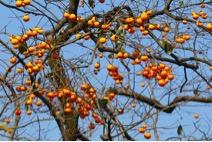Persimmon
-
Scientific NameDiospyros kaki
-
General InformationPersimmons ("fruit of the Gods") are deciduous trees with luscious, prolific fruit and great ornamental value. Marin provides the perfect climate of moderate winters and mild summers. Large, dark green, glossy leaves turn yellow in autumn. After leaf drop, fruit remains on bare branches for an attractive winter display.
 Photo: Pixabay
Photo: Pixabay -
When to Plant
Purchase bare root from a quality nursery.
Plant December through January.
Choose specimen with trunk approximately one-half inch in diameter.
-
Planting
Site in full sun with adequate space to allow for air movement. Trees may reach 25 feet tall and wide.
Learn more about planting bare root trees.
-
Soil Requirements
Amend clay soil with compost. Will tolerate a variety of soil types. Loamy soil is best. Provide good drainage.
-
Water Requirements
Irrigate in spring when rainfall is inadequate and in summer to maintain moisture and prevent leaf and fruit drop. Generally requires 36 to 48 inches of water annually, applied in spring and summer and tapering off in the fall. May withstand short periods of drought once established but needs regular watering to produce a good crop.
-
Fertilizing
Fertilize lightly if tree leaves are not dark green or if shoot growth is less than one foot per year. Use balanced N-P-K 10-10-10 and apply one pound per inch of trunk diameter. Best time to fertilize is in the spring when new growth appears. Spread under canopy of tree.
-
Pollination
Self-pollinating.
-
Harvesting
Use a pair of clean gardening scissors or pruning shears to cut the stem of the fruit above the calyx. Leave the calyx intact until you eat or process the fruit to prevent rot.
'Fuyu' persimmons are ready for harvest when color turns from green to orange, usually in mid October to mid November. The fruit will be firm but sweet.
'Hachiya' persimmons are ready for harvest when color changes to orange between October and January and begins softening. This variety can be harvested and ripened off the tree.
-
Storage
'Fuyu': Eat soon after picking if ripe. Store in refrigerator or in a cool location one week to one month depending on ripeness. 'Fuyu' persimmons will soften slightly once harvested and are easily bruised. For longer storage, freeze up to six months.
'Hachiya': Firm, astringent fruits that can be dried. Fully ripened fruit can be pureed for use in baking or smoothies. Puree can be frozen up to one year.
-
Good Varieties for Marin
'Fuyu' and 'Hachiya' are the two most popular varieties.
Chocolate persimmon (Diospyros sapote) is another interesting and popular variety.
-
Helpful Tips
'Fuyu' persimmons are non-astringent so they are good eaten out of hand or used in salads.
'Hachiya' are astringent, so they must be completely soft to be eaten. This is a good fruit for use in baking.
Prune when young for strong framework: a modified leader system with lateral branches. In years one to two, pinch off vigorous shoot growth to force growth into the framework. Pruning of mature trees should be light and focused on diseased, decayed or damaged branches. Fruit sets on current year's growth.
Can also be pruned as a hedge, screen, or espalier.
Learn more about pruning persimmon trees.
-
Common Problems
If 'Hachiya' persimmons are left on the tree to fully ripen you will be competing with birds for harvest.
Sunburn can be a problem where summers are hot and trees receive prolonged sun exposure.
-
Pests- Diseases & More
Generally disease- and pest-free.
Insect pests include mealybugs and scale, which produce honeydew, which, in turn, draws ants. Deter using banding material and insect barrier.
Vertebrate pests include squirrels, deer, rats, birds, and gophers.

